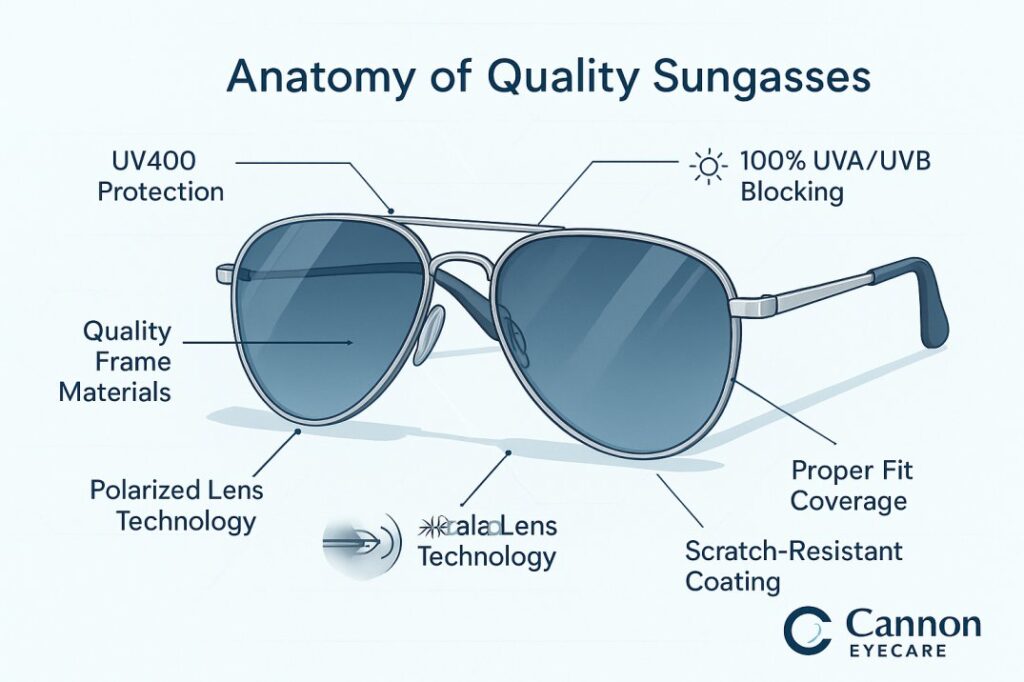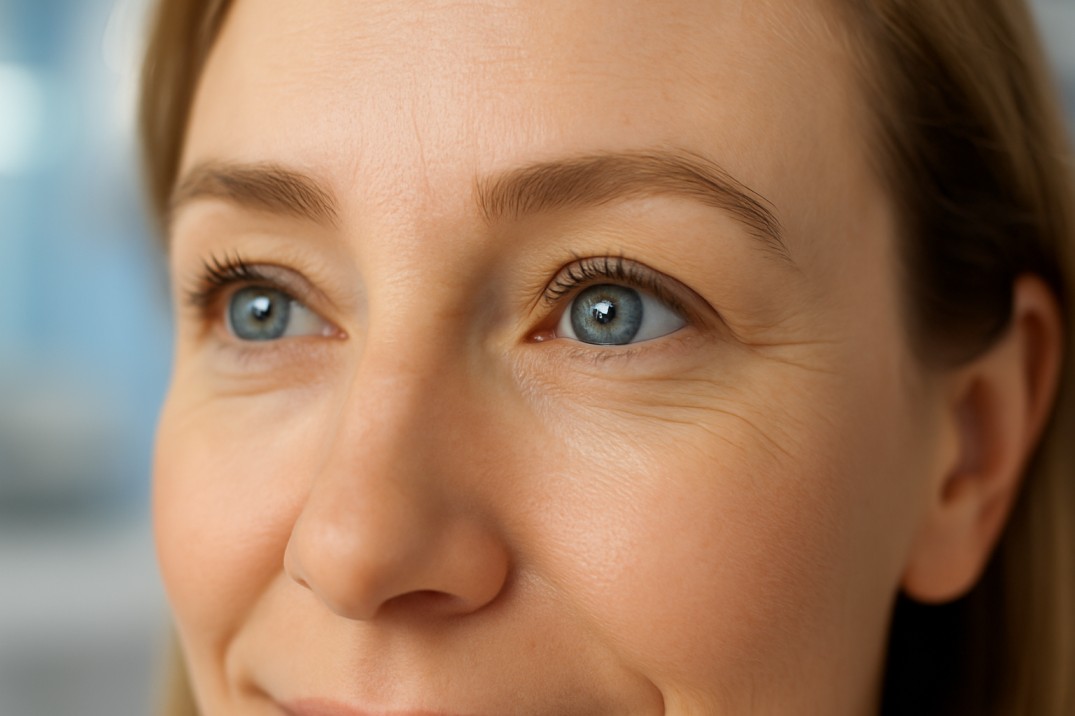How to Choose Perfect Sunglasses: Expert Guide to Eye Protection
Bottom Line Up Front:
Finding the perfect sunglasses in 2025 requires balancing three key factors: 100% UV protection, proper fit for your face shape, and quality lenses. When you’re looking for what to look for in sunglasses, start with UV protection—look for a sticker or tag that promises 100% UV protection from all types of UV light. Some labels say “UV absorption up to 400nm,” which is also acceptable. Whether you’re shopping for professional guidance in Cannon EyeCare’s Seattle locations at University Village or exploring other options, prioritizing eye health while maintaining style has never been more important.
Understanding UV Protection: The Foundation of Quality Sunglasses
Why UV Protection Matters More Than Ever
UV rays—including UV-A and especially UV-B—damage the eye’s surface, cornea, and lens. That damage can lead to cataracts, macular degeneration, and other eye conditions that can permanently damage your sight. Research shows that our eyes are 10 times more sensitive to UV than our skin, but only 7% of the population is aware of the risks of UV to their eyes, according to recent optical industry studies.
The Gold Standard: UV400 Protection
When shopping for sunglasses in 2025, look for sunglasses labeled UV 400, which provide nearly 100% protection from harmful ultraviolet light rays. UV 400 protection lenses block wavelengths up to 400 nanometers. This level of protection is crucial because UV400 sunglasses block 100% of harmful UVA and UVB rays, providing complete protection for your eyes against sun damage.
Common UV Protection Myths Debunked
Myth: Darker lenses offer better UV protection. Dark sunglasses don’t offer more protection. When you put on a very dark pair of sunglasses, your pupils open up and allow much more light into your eyes than if you didn’t wear those sunglasses at all. The key is the UV-blocking coating, not the lens darkness.
Myth: Expensive equals better protection. Effective UV protection, meaning full coverage (i.e., protection on both sides of the lens as well as lens size), is what matters, and it’s not impossible to find cheaper shades that will adequately protect your eyes.
Essential Features to Look for in Sunglasses
When determining what to look for in sunglasses, these core features should guide your decision-making process:
1. Lens Quality and Material
Polycarbonate Lenses: Lightweight, impact-resistant, and affordable. An excellent choice for active lifestyles.
Glass Lenses: While offering the highest optical clarity, they are also the heaviest and most susceptible to shattering, so they are not advisable for high-impact sports or activities.
Quality Testing: Look at something with a rectangular pattern, like a tiled floor. Hold the glasses at a comfortable distance from your face while covering one eye. Move the glasses slowly from side to side, then up and down, looking through the lenses. If the rectangular lines stay straight, the lenses are fine.
Frame Size and Coverage
When considering what to look for in sunglasses, size and coverage are crucial factors. Large lenses not only embrace the oversized sunglasses trend that’s popular in 2025, but they also offer the largest shield from sun damage. Wraparound-style sunglasses offer even more protection by preventing UV rays from entering along the sides. Research indicates that the cornea, the cheand the nose receive the highest UV doses during a cloudless summer day.
Polarization Benefits
Understanding what to look for in sunglasses includes knowing when polarization matters. Polarized lenses substantially reduce glare and are a great feature if you enjoy water sports or are especially sensitive to glare. However, it’s important to note that polarized lenses and UV protection are paired in most sunglasses because polarization alone doesn’t provide UV protection.
Choosing Sunglasses for Your Face Shape
Round Face Shape
If you have a round face, choose glasses frames that are wider than your face or are slightly oversized, so that they will add balance to your soft features and balance your face to make it look longer or thinner.
Square Face Shape
For square faces, round sunglasses soften angularity and give a balanced look. Wayfarer and sport styles, with their slightly curved edges, are also flattering.
Oval Face Shape
Oval faces have it made because every frame looks awesome! Oval faces have gently rounded, fairly even features, and pretty much any frame is going to work well on them.
Heart-Shaped Face
The best sunglasses for heart and triangle-shaped faces feature wide lower edges with no straight lines along the top because they shift attention downward and elongate the face.
2025 Sunglasses Trends and Styles
Oversized Frames Making a Statement
Oversized sunglasses are no new phenomenon. They were popularized by Jackie Kennedy Onassis in the 1960s and then again by Mary-Kate and Ashley Olsen in the early 2000s. In 2025, oversized pairs completed new-bohemian looks of head-to-toe florals and flowy frocks.
Futuristic and Tech-Forward Designs
Futuristic sunglasses are making a bold impact in 2025, pushing the boundaries of eyewear design. Shield styles by Balenciaga and Acne offer a sleek, angular aesthetic.
Classic Aviators Remain Timeless
Aviators are an iconic glasses shape, with a main character-esque style. When done properly, they have a cool ’70s aura that pairs effortlessly with even the most modern of fits.
Colorful and Tinted Lenses
For spring/summer 2025, the standout eyewear trend takes on various shades of yellow, with butter yellow leading the way.
Shopping for Sunglasses: What to Consider
Activity-Specific Features
For Driving: Look for polarized lenses to reduce glare and enhance contrast, making those long drives a breeze.
For Sports: Look for sports sunglasses for outdoor activities with a secure fit and shatter-resistant lenses.
For Water Activities: Polarized lenses substantially reduce glare and are particularly beneficial for boating, fishing, and beach activities.
Fit and Comfort Factors
Frames should fit snugly on your nose and ears, but not pinch or rub. The weight of sunglasses should be evenly distributed between your ears and nose. For optimal comfort, your eyelashes should not contact the frame.
Consumer Preferences in 2025
Current market data shows that adults strongly prefer sunglasses with square frames (51% preference) or aviator shapes (37% preference), with black and grey lenses being most popular (60% preference). Non-polarized sunglasses dominate the market with a 65.9% share, while polarized options account for 34.1% of sales.
Professional Eye Care: The Cannon EyeCare Advantage
When choosing sunglasses in the Seattle area, working with experienced optometry professionals in Cannon EyeCare’s University Village and Pike Place Market locations offers several advantages:
Comprehensive Eye Exams
Professional eye care providers in Cannon EyeCare can assess your specific vision needs and recommend prescription sunglasses if needed, ensuring both protection and optimal vision correction.
Expert Fitting Services
Trained opticians in Cannon EyeCare understand how proper fit affects both comfort and protection, helping you find sunglasses that provide maximum coverage for your facial structure.
Quality Assurance
Reputable optometry practices like those in Cannon EyeCare carry sunglasses from trusted manufacturers with verified UV protection ratings, eliminating guesswork about safety standards.
Recent Scientific Research on Eye Protection
Study 1: UV Exposure and Eye Health (2019)
Research published in scientific journals confirms thatthe highest ocular daily UVR doses were estimated at the uncovered cornea (1718.4 J/m2), emphasizing the critical importance of comprehensive eye protection. This study used advanced 3D modeling to predict UV radiation doses received by the eyes in different exposure situations.
Study 2: Market Growth and Consumer Awareness (2025)
The global sunglasses market reached USD 27.6 billion in 2025 and is anticipated to rise at an 8.4% CAGR from 2025 to 2035, driven by growing consumer consciousness regarding UV protection and eye health, along with increasing demand for designer eyewear that integrates fashion and functionality.
Study 3: Consumer Behavior Research (2023)
According to The Vision Council’s survey, 72% of adults reported primarily wearing sunglasses to help see better when the sun is too bright, and 62% reported using sunglasses for protection from UV light, indicating strong market penetration and consumer awareness of protective benefits.
Lens Categories and Protection Levels
Category 0-1: Light Tints
Category 0-1 sunglasses are suitable for overcast conditions but provide minimal light reduction and are primarily for fashion rather than serious sun protection.
Category 2: Medium Tints
Suitable for moderate sunlight conditions with good UV protection and comfortable light reduction for everyday wear.
Category 3: Dark Tints
Category 3 sunglasses are the most common category and provide added protection from UV light. Our standard dark sunglasses tints are within this category, offering 100% UV protection and filtering out 75% of the light.
Category 4: Very Dark Tints
Category 4 lenses are often a very dark grey or brown. They are ideal for specialist purposes like mountaineering, but not suitable for everyday wear or driving in the UK.
Maintenance and Care Tips
Proper Cleaning Techniques
Avoid cleaning sunglasses with clothing or rough materials. Cleaning the glasses with the tip of the clothes and throwing them in the bag or pocket randomly is one of the most common mistakes. These errors cause micro scratches on the glass.
Storage Solutions
Invest in a quality case to protect your sunglasses when not in use. Proper storage prevents scratches and maintains the integrity of UV-protective coatings.
Regular Professional Checkups
Take them to an optical shop, where they can be tested in a photometer. Most opticians will test them for free, and it takes less than 30 seconds.
Special Considerations for Different Age Groups
Children’s Sunglasses
Damage from UV exposure in childhood often doesn’t show up until you’re in your 40s (or later),.It’s crucial to ensure you use UV 400 sunglasses throughout your life to protect your eyes from permanent damage.
Seniors and Medicare Considerations
For older adults, especially those dealing with cataracts or macular degeneration, consider amber or brown lenses, which can help you see better.
Active Lifestyle Considerations
Sport sunglasses also typically feature grippy nose pads and temple ends, a feature that helps keep the frames in place even when you’re sweating.
Environmental and Seasonal Factors
Year-Round Protection
UV rays aren’t necessarily blocked by cloud cover, so your eyes could be at risk even on overcast days. This makes quality sunglasses essential throughout the year, not just during summer months.
Special Considerations for the Seattle Environment
Seattle’s UV index is generally low, often between 1 and 3, due to frequent cloud cover and its northern location. However, summers can see moderate increases, sometimes reaching 5 to 6 on clearer days, with peak UV readings occasionally reaching up to 8.7 during very high exposure periods. Even with Seattle’s typically cloudy weather, UV rays can penetrate cloud cover, making year-round eye protection essential.
Water and Beach Activities
Reflective surfaces like water significantly increase UV exposure, making polarized, wraparound sunglasses particularly beneficial for aquatic activities.
Technology and Innovation in 2025 Sunglasses
Smart Features
The eyewear industry is incorporating new technologies, including blue light filtering, transition lenses, and even augmented reality features in premium sunglasses.
Sustainable Materials
Consumer preference is shifting towards sustainable and ethically produced sunglasses, which results in growing demand for recyclable lenses and biodegradable frames.
Market Trends and Innovation
The sunglasses industry in 2025 reflects significant growth, with the global market reaching USD 27.6 billion and projected to expand to USD 61.8 billion by 2035. Consumer preferences are shifting toward sustainable materials, with companies like Ray-Ban launching recycling programs where 99% of frames are made from recycled materials. Smart sunglasses featuring audio functionality, fitness tracking, and augmented reality are gaining momentum among technology-oriented consumers.
Making Your Final Decision
Essential Checklist
Before purchasing sunglasses, ensure they meet these criteria:
- 100% UV protection (UV400 rating)
- Proper fit for your face shape and size
- Quality lens construction without distortion
- Appropriate style for your intended activities
- Durable frame construction
- Professional verification of protection levels
Professional Consultation
Consider visiting qualified optometry professionals like those at Cannon EyeCare for personalized recommendations based on your specific vision needs, lifestyle, and facial features.
Summary: Your Path to Perfect Sunglasses
Choosing the right sunglasses in 2025 involves more than just following fashion trends. Prioritize UV400 protection, ensure proper fit for your face shape, and consider your specific lifestyle needs. Whether you’re looking for everyday wear, sports activities, or special occasions, the combination of professional guidance and quality construction will provide both optimal eye protection and enduring style.
Remember that sunglasses are a long-term investment in your eye health. Take time to research what to look for in sunglasses, try on different styles, and consult with eye care professionals in Cannon EyeCare to make an informed decision that will serve you well for years to come.
FAQs
-
Look for 100% UV protection, high-quality lenses, a comfortable fit, durable frames, and a style that suits your face shape for the best eye safety and comfort




